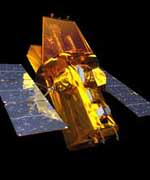NASA’s Swift satellite successfully launched today aboard a Boeing Delta 2 rocket at 12:16 p.m. EST from Launch Complex 17A at the Cape Canaveral Air Force Station, Fla. The satellite will pinpoint the location of distant yet fleeting explosions that appear to signal the births of black holes.
About 80 minutes after launch, the spacecraft was successfully separated from the Delta second stage. It has also been confirmed that the solar arrays are properly deployed.
“It’s a thrill that Swift is in orbit. We expect to detect and analyze more than 100 gamma-ray bursts a year. These are the most powerful explosions in the universe, and I can’t wait to learn more about them,” said Swift Principal Investigator Dr. Neil Gehrels, at NASA’s Goddard Space Flight Center, Greenbelt, Md.
Each gamma-ray burst is a short-lived event, lasting only a few milliseconds to a few minutes, never to appear again. They occur several times daily somewhere in the universe, and Swift should detect several weekly.
Swift, a mission with international participation, was designed to solve the 35-year-old mystery of the origin of gamma-ray bursts. Scientists believe the bursts are related to the formation of black holes throughout the universe – the birth cries of black holes.
To track these mysterious bursts, Swift carries a suite of three main instruments. The Burst Alert Telescope (BAT) instrument, built by Goddard, will detect and locate about two gamma-ray bursts weekly, relaying a rough position to the ground within 20 seconds. The satellite will swiftly re-point itself to bring the burst area into the narrower fields of view of the on-board X-ray Telescope (XRT) and the UltraViolet/Optical Telescope (UVOT). These telescopes study the afterglow of the burst produced by the cooling ashes that remain from the original explosion.
The XRT and UVOT instruments will determine a precise arc-second position of the burst and measure the spectrum of its afterglow from visible to X-ray wavelengths. For most of the bursts detected, Swift data, combined with complementary observations conducted with ground-based telescopes, will enable measurements of the distances to the burst sources.
The afterglow phenomenon can linger in X-ray light, optical light, and radio waves for hours to weeks, providing detailed information about the burst. Swift will check in on bursts regularly to study the fading afterglow, as will ground-based optical and radio telescopes. The crucial link is having a precise location to direct other telescopes. Swift will provide extremely precise positions for bursts in a matter of minutes.
Swift notifies the astronomical community via the Goddard-maintained Gamma-ray Burst Coordinates Network. The Swift Mission Operations Center, operated from Penn State’s University Park, Pa., campus, controls the Swift observatory and provides continuous burst information.
“Swift can respond almost instantly to any astrophysical phenomenon, and I suspect that we’re going to be making many discoveries which are currently unpredicted,” said Swift Mission Director John Nousek, Penn State professor of astronomy and astrophysics.
Goddard manages Swift. Swift is a NASA mission with the participation of the Italian Space Agency (ASI) and the Particle Physics and Astronomy Research Council in the United Kingdom.
Swift was built through collaboration with national laboratories, universities and international partners, including General Dynamics, Gilbert, Arizona; Penn State University; Los Alamos National Laboratory, New Mexico; Sonoma State University, Rohnert Park, Calif.; Mullard Space Science Laboratory in Dorking, Surrey, England; the University of Leicester, England; ASI-Malindi ground station in Africa; the ASI Science Data Center in Italy; and the Brera Observatory in Milan, Italy.
For more information about Swift on the Internet, visit:
http://www.nasa.gov/swift and http://swift.gsfc.nasa.gov
Original Source: NASA News Release

